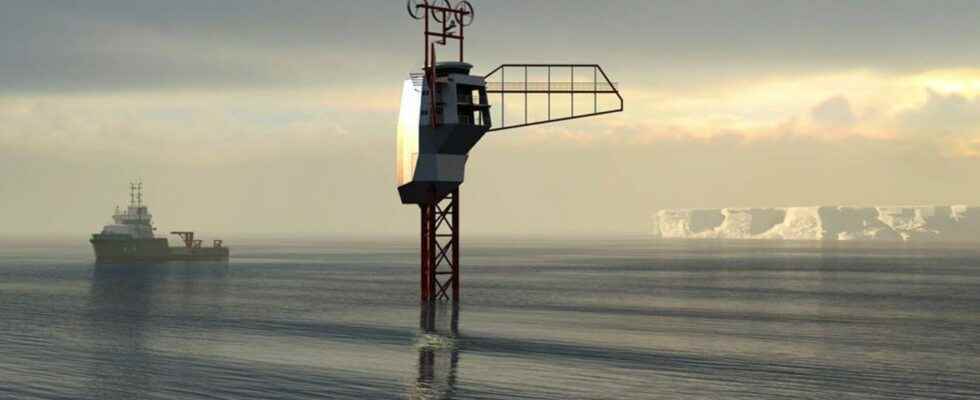World Oceans Day, next Wednesday June 8, will allow us to continue studying the oceans that we know better and better, but not yet enough, which is why the explorer and scientist Jean-Louis Étienne is launching the construction of its Polar Pod project, an inhabited oceanographic platform, a revolutionary vertical vessel that will enable the Southern Ocean to be studied. A scientific and technological challenge.
The ocean alone absorbs 93% of excess heat! It is also a carbon sink and an oxygen supplier that enables one in two breaths on the planet. “We can say thank you to him!”, says Jean-Louis Étienne who has traveled the seas for years. This former turner-miller, who became a doctor of medicine and an intern in surgery, has devoted his life to discovering the planet.
As a doctor, he was a crew member aboard Eric Tabarly’s Pen Duick VI, during his race around the world in 1977/78. He also participated in numerous expeditions to the Himalayas, Greenland and Patagonia, until becoming the first man to reach the North Pole alone, in 1986. Three years later, he did it again in Antarctica (South Pole) and realizes the Transantarctica.
“The Polar Pod is a flip of the seas.”
Jean-Louis Étienne, doctor and explorerat franceinfo
The Southern Ocean is little known because it is simply far away, and rare are the scientific missions that venture into these hostile zones, swept by the winds of the Roaring 40ths and the Howling 50ths, as the sailors have baptized this stormy ocean. “It is an open ocean that circulates around Antarctica”, explains Jean-Louis Etienne. A huge ocean with an area of 20.33 million km2.

Although the Southern Ocean is still little known, it is nevertheless a major player in climate and marine biodiversity, hence the need to explore it more carefully in order to collect in situ measurements.
Jean Louis Etienne therefore imagined a vertical ship 100 meters high with an 80-meter submerged part. The construction of this extraordinary ship will be launched soon because the explorer has finally collected the money necessary to carry out this mission which will last three years. It took 10 years for this machine worthy of a Jules Verne novel to finally see the light of day!
The Polar Pod is a kind of floating laboratory, halfway between a boat and a scientific platform. During its three-year mission, the ship will drift on the Southern Ocean, carried by the circumpolar current. “The interest of verticality is stability”explains Jean-Louis Etienne. The Polar Pod has a draft (submerged part) of 80 meters. The habitable part will therefore be far from the surface, and will benefit from more stable waters that will not be impacted by the wind.
On the surface, the wind and the sea meet, forming monstrous waves in this region of the globe. Being underwater, these disturbances will be much less felt. The ship will be loaded with sensors and will circle the world twice during the three-year mission, which will begin at the end of 2023.
“The Southern Ocean is huge” explains Jean-Louis Etienne, 22,000 kilometers in circumference”, it is the main carbon sink on the planet because its waters are very cold, between 0 and 8 degrees in summer! We know that CO2, the carbon dioxide that we emit in excess, dissolves primarily in cold water. It is estimated that the Southern Ocean alone absorbs half of all the CO2 absorbed by the oceans.

“The waves mix the air, trap the air bubbles, which makes it possible to dissolve the CO2, continues the explorer. The Polar Pod should therefore make it possible to obtain very precise data on the exchanges between the atmosphere and the ocean. Fundamental data to understand the evolution of the climate”, insists Jean-Louis Étienne. The objective of this expedition coordinated by the CNRS, in partnership with IFREMER and the CNES (national center for space studies), will also be to collect data on biodiversity thanks to acoustics in particular.
The Polar Pod is silent, it glides on water, but it will be equipped with hydrophones, very powerful microphones installed under water, which will make it possible to draw up an acoustic inventory of the fauna present in this remote area of the world. A kind of sound map of the ocean that will identify the different species.
The Polar Pod, which will therefore drift in very windy areas, will work thanks to 6 wind turbines of 3 kilowatt hours each and 2 battery packs of 50 kilowatt hours for domestic and scientific needs. The crew will also benefit from an emergency generator, but the primary objective is the “zero emissionssays Jean-Louis, the motor is the current, and the electricity is the wind”, he said.
A total of 80 scientists should take turns aboard the Polar Pod. Crew changes will take place every two months at sea, thanks to a boat called “Perseverance”. The crew will consist of 3 sailors and 4 scientists. The shipment is due to depart from Port Elizabeth, South Africa, in December 2023.
The return is scheduled for December 2026.
